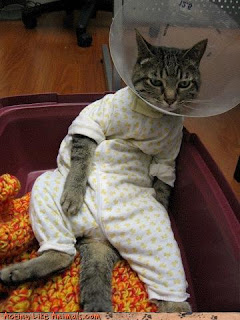At the beginning of week 2, I had my first post-op appointment. A St. Jude rep met me at the doctor to reprogram the stimulator (a different rep from the one who programmed me in the hospital after surgery) and a nurse examined my incisions.
The St. Jude rep was able to explain why it was so painful to turn the stimulator on. There are 8 contact points on each lead, and with each program you can specify which contact points get stimulation. The programs I was set up with in the hospital only used one contact point on each lead - which was the equivalent of someone just poking me hard in one spot on my head according to the rep. I was pretty irritated with that information because it didn't make sense. My head was already very sensitive from the surgery, so this type of stimulation was just downright painful.
The rep gave me 4 more programs to use. One issue we kept running into when programming the left lead (over my AT nerve) was that the contact points at the top of the lead cause my jaw to spasm when turned on. This irritates the trigeminal nerve and causes quite a bit of pain. Unfortunately, it's these contact points that enable the stimulation to cover my most sensitive area - my temple in front of the ear. As I continue to heal, it's slightly possible that this will stop happening. The trauma from the surgery causes fluid build up around the leads. Fluid is a conductor, so the stimulation you feel after surgery is more intense.
The rep also showed me how to charge the battery and advised that I charge it fully at least once a week. I can charge it all at once or in several small increments of time. The first time I charged I had about a 1/3 of the battery power left, and it took me 50 minutes to fully charge it.
The nurse that examined my incisions said everything was healing well. When I asked about the bump that formed under the top part of the right lead, she was encouraged that I had noticed some reduction in size throughout the first week. She told me to continue monitoring it and that they would check it again in 4 weeks. When I inquired about the tightness of the wires, which by that point had become very uncomfortable, she attributed it to swelling and asked if I had been wearing my cervical collar. I was nonplussed by this question. When I told her that I didn't know what she was talking about, she informed me that the hospital was supposed to give me a cervical collar when I left and that I was supposed to be wearing it during my recovery. After doing some digging of my own, it turns out my doctor never put in a request for the collar, so the hospital didn't give me one. I was incensed by this oversight and when I tried to contact the hospital to pick one up, they didn't know what to give me and couldn't get my doctor on the phone. Luckily, a friend of mine had one and let me borrow it.
Once I put it on, my neck pain immediately reduced and I no longer had the tugging pain on the leads. Because I've had several years of a mostly "bed rest" life, my neck muscles are very weak. After the surgery, I was sitting upright 24/7 trying to support my head. I have a natural forward head posture, and this posture put strain on the wires which in turn tugged on the leads, further irritating the discomfort there. So the cervical collar gave my neck muscles a much needed break and allowed me to hold my head in the correct position.
 |
This is pretty much what I looked like sitting on the couch in my PJs with my cervical collar on. ;) |
Even with the cervical collar and reprogramming, I still had a rough week with terrible headaches most of the time. I kept the stimulator on all the time and even though the stimulation was pleasant, it still didn't seem to be helping enough because I wasn't getting sufficient coverage. The doctor and St. Jude reps all stress that as I heal, I will start feeling better coverage because I'll be able to turn the unit up higher and they'll be able to program the stim better.
During week 2 I also had to start a mostly liquid diet. The left lead that covers the AT nerve is on the side of my head, just above my ear. That whole area was super sensitive, and when I chewed it irritated it more and caused headaches. So, from that moment on until today as I write this (almost 4 weeks post-op), I've been living on smoothies, creamy soups, and pureed foods. Here is my favorite smoothie recipe. It helps me get sufficient protein on this restricted diet.
Like in week one, I spent the whole time on the couch watching movies or on the massage table. Friends continued to visit bringing meals, which always helped take my mind off the pain. I still took my pain meds around the clock and used ice packs religiously.









